Brain Abnormalities Seen in Military Members with Blast Exposure
Released: April 01, 2025
- RSNA Media Relations
1-630-590-7762
media@rsna.org - Linda Brooks
1-630-590-7738
lbrooks@rsna.org
OAK BROOK, Ill. (April 1, 2025) — In military service members with a history of repetitive blast exposure, researchers found that higher blast exposure correlated with changes in the functional connectivity between brain regions, according to a new study published today in Radiology, a journal of the Radiological Society of North America (RSNA). Even when standard MRI exams appeared normal, the researchers found clear abnormalities using more advanced MRI techniques.
"We found that service members with more blast exposure had more severe symptoms—including memory problems, emotional difficulties and signs of post-traumatic stress disorder—and that their brains showed weaker connectivity in key areas," said lead author Andrea Diociasi, M.D., neuroradiologist and past research fellow in the Department of Radiology at Massachusetts General Hospital and Harvard Medical School in Boston. "In short, repeated trauma seems to weaken the brain's internal communication."
Traumatic brain injury has diverse negative consequences for military personnel, affecting both the brain's structure and function. These effects are especially alarming for Special Operations Forces members who often face multiple blast injuries. Understanding the long-term neuroimaging implications of repeated blast injuries is challenging due to the variability of injuries in intensity, force and recurrence, underscoring the multiscale neurological implications of repeated trauma.
The research team analyzed structural and resting-state functional MRI data of Special Operations Forces members and the relationship between the frequency of blast injuries, persistent clinical symptoms and related changes to volume measurements in the cerebral cortex—the layer of the brain responsible for higher-level cognitive function—as well as functional connectivity changes. Functional connectivity refers to the activity between different brain regions, reflecting how they interact and exchange information to support various cognitive and behavioral processes.
Included in the study were 212 service members with a history of repetitive blast exposure who underwent psychodiagnostics and a comprehensive neuroimaging evaluation. The group of service members were split into two datasets for model development and validation, and each dataset was divided into high and low exposure groups based on participants' exposure to various explosives. An external age and gender-matched healthy control group of 212 participants was included in the volumetric analysis.
"We looked at over 200 Special Operations Forces members who had been exposed to blasts. Even though their brains looked normal on traditional exams, we used advanced MRI to find that the ones with more blast exposure had noticeable differences in brain activity and brain structure," Dr. Diociasi said.
The service members also reported more symptoms such as anxiety, mood swings, irritability, poor concentration, forgetfulness, slowed thinking, headaches, nausea, fatigue, dizziness and balance problems, Dr. Diociasi noted.
"These symptoms were significantly more common in individuals with higher blast exposure and were linked to measurable changes in brain connectivity on advanced imaging," he said. "The more blasts someone had experienced, the more these symptoms tended to show up—and the more their brain function seemed affected."
Dr. Diociasi said that across very different populations, the same pattern emerges: mild but repetitive trauma can have lasting effects.
"We're validating and expanding on prior work using a much larger and very specific population—Special Operations Forces—while also showing that these issues likely extend beyond the military," he said. "The broader implication is that we need to rethink how we view 'mild' brain injuries, not just in soldiers, but across society."
The study challenges the idea that "invisible" injuries are harmless. Dr. Diociasi notes that many people experience multiple head impacts in their lives—whether through military service, sports, accidents or other sources. The findings show that even if these injuries don't cause obvious damage on a standard imaging exam, they can still change how the brain functions.
"We also noticed certain brain regions were actually larger in more-exposed individuals, which could reflect long-term tissue changes like scarring," he said. "These aren't injuries you can always see with the naked eye, but they are real—and now we can start measuring them."
"The findings reveal that even when the brain looks 'normal,' it might still be carrying hidden signs of trauma—and we now have tools to detect them," Dr. Diociasi said. "That opens the door for earlier detection, better treatment, and a deeper understanding of how repeated trauma affects the brain over time."
Dr. Diociasi said that with their multimodal approach, the researchers tried to connect the dots.
"But even now, many are still missing—filling in those gaps is the challenge ahead," he said.
"Distinct Functional MRI Connectivity Patterns and Cortical Volume Variations Associated with Repetitive Blast Exposure in Special Operations Forces Members." Collaborating with Dr. Diociasi were Mary A. Iaccarino, M.D., Scott Sorg, Ph.D., Emily J. Lubin, B.A., Caroline Wisialowski, B.A., Amol Dua, M.D., Can Ozan Tan, Ph.D., and Rajiv Gupta, Ph.D.
Radiology is edited by Linda Moy, M.D., New York University, New York, N.Y., and owned and published by the Radiological Society of North America, Inc. (https://pubs.rsna.org/journal/radiology)
RSNA is an association of radiologists, radiation oncologists, medical physicists and related scientists promoting excellence in patient care and health care delivery through education, research and technologic innovation. The Society is based in Oak Brook, Illinois. (RSNA.org)
For patient-friendly information on brain MRI, visit RadiologyInfo.org.
Images (JPG, TIF):
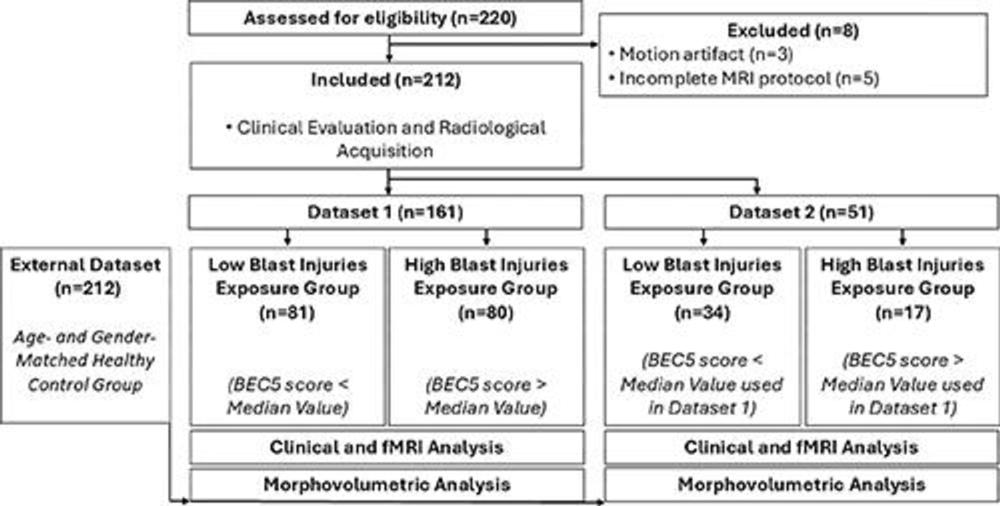
Figure 1. Flowchart depicts participant selection, dataset division, and analysis pipeline. A total of 220 participants were initially assessed for eligibility. Eight participants were excluded due to motion artifacts (n = 3) or incomplete MRI protocols (n = 5), resulting in a final sample of 212 participants. The cohort was divided into two datasets: dataset 1 (n = 161) and dataset 2 (n = 51). Each dataset was further stratified into low and high blast injury exposure groups based on the median blast exposure count 5 (BEC5) value from dataset 1. Dataset 2 was used as an independent validation set, employing the same median BEC5 threshold as dataset 1. Analyses included clinical assessments, functional MRI (fMRI) connectivity analysis, and morphovolumetric evaluations. Additionally, an external age- and sex-matched healthy control group (n = 212) was incorporated for volumetric comparisons.
High-res (TIF) version
(Right-click and Save As)
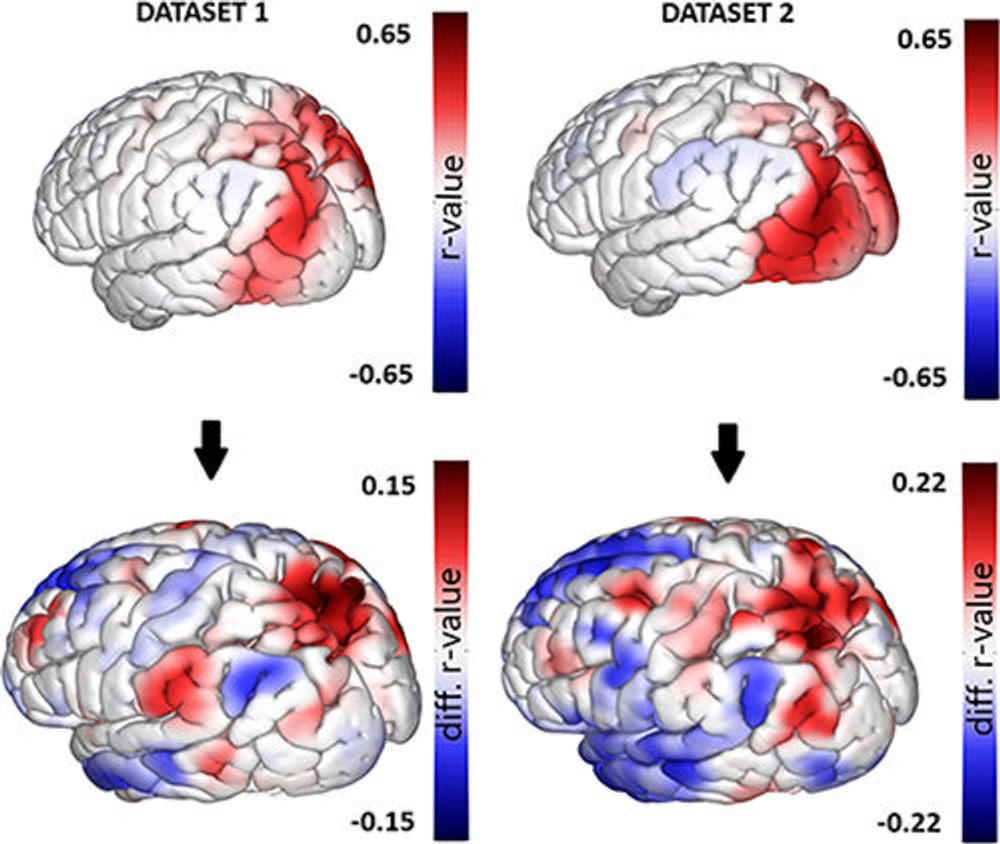
Figure 2. Upper panel displays functional MRI (fMRI) maps obtained from the functional connectivity multivariate patterns analysis conducted on dataset 1 and dataset 2. In particular, the average connectivity across all participants is illustrated with one of the clusters that showed differences between the groups. The colors depict the r value ranging from red to blue. Images in bottom panel highlight the differences between groups (color coded from red to blue), focusing on the same cluster chosen as a seed in the top row. The average connectivity is illustrated with the contrasted cluster across participants, showing a comparable disparity between the two datasets.
High-res (TIF) version
(Right-click and Save As)
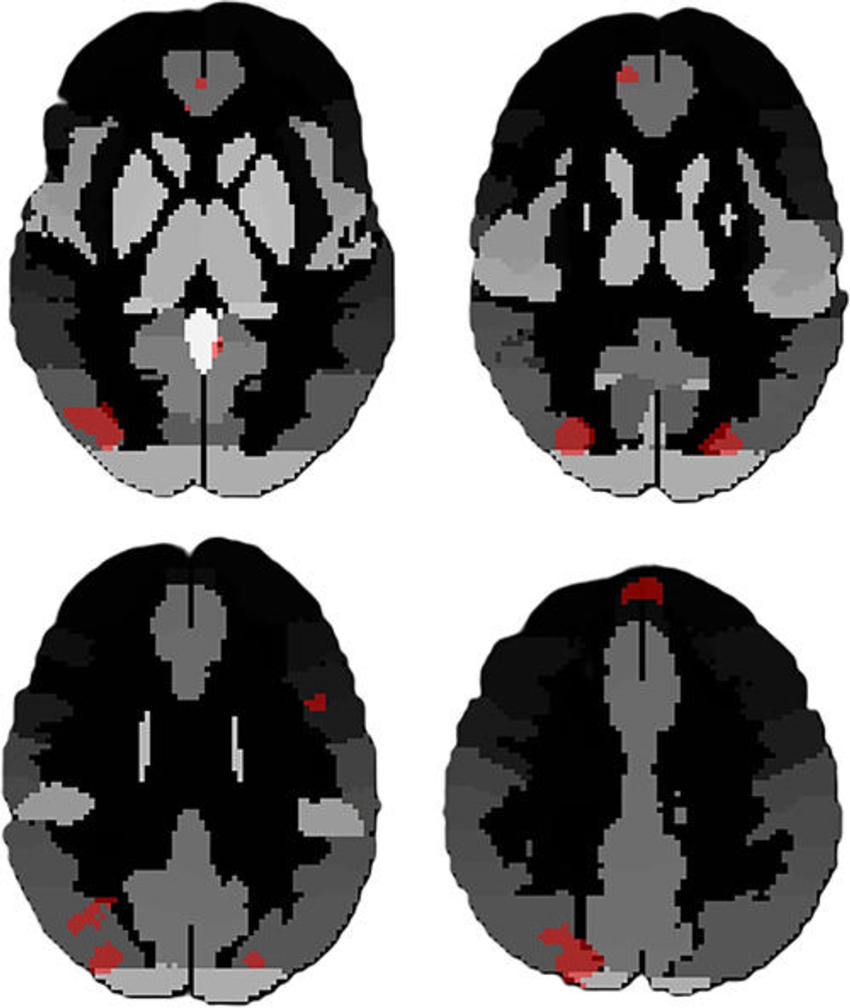
Figure 3. Functional MRI (fMRI) scans depict the merged regions of interest that showed significant differences between the high and low blast exposure groups in both dataset 1 and dataset 2. These regions of interest were combined to create a unified representation of the second-level analysis. These regions were used in the model to predict group membership solely based on fMRI data. The clusters involved the bilateral superior and inferior lateral occipital cortex, the frontal medial cortex, left superior frontal gyrus, and precuneus.
High-res (TIF) version
(Right-click and Save As)
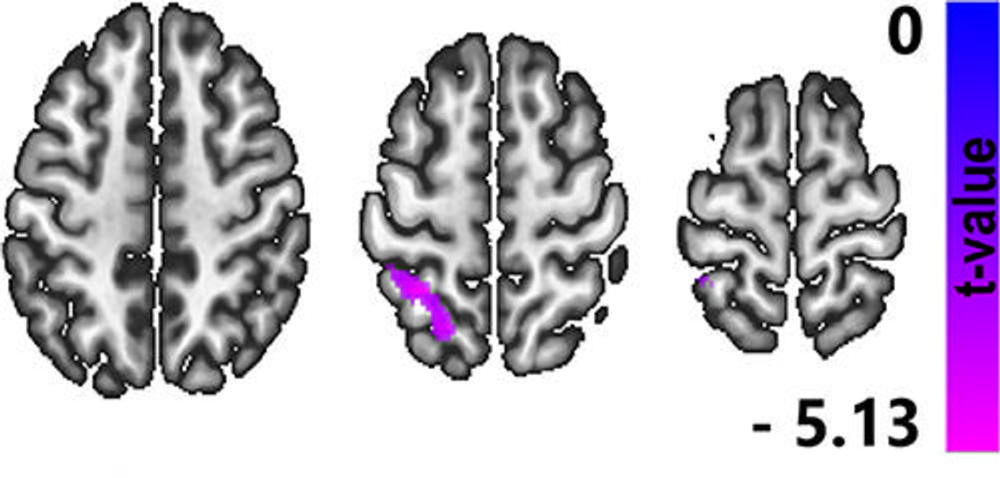
Figure 4. Functional MRI scans highlight the effect of Neurobehavioral Symptom Inventory (NSI) score on functional MRI connectivity while controlling for median blast exposure count 5 value and using lateral occipital cortices as the reference seed. NSI demonstrates a negative correlation with functional connectivity between the seed regions (lateral occipital cortices) and a cluster centered in the left superior parietal lobule, suggesting that higher symptom severity is linked to weaker communication between these brain regions.
High-res (TIF) version
(Right-click and Save As)
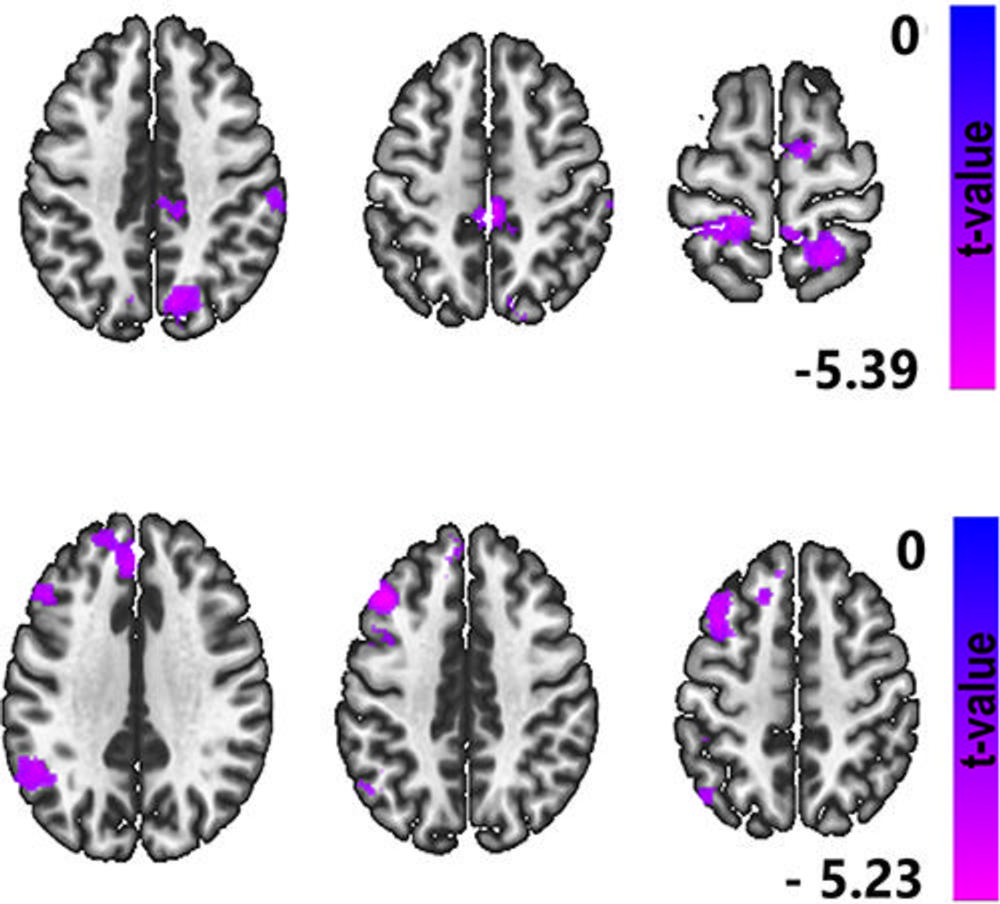
Figure 5. Functional MRI (fMRI) scans highlight the effect of the Posttraumatic Stress Disorder Checklist for Diagnostic and Statistical Manual of Mental Disorders (Fifth Edition) (PCL-5) score on fMRI connectivity while controlling for blast exposure count 5 value using as the reference seeds the precuneus (top row) and default node networks (DMNs) (posterior cingulate cortex, lateral parietal left, lateral parietal right, medial prefrontal cortex) (bottom row), suggesting that greater posttraumatic stress disorder symptom severity is associated with weaker connections in brain regions involved in attention, memory, and emotional regulation. Pearson correlation analysis showed that NSI is negatively correlated with functional connectivity (FC) between superior lateral occipital cortices (LOCs) and regions involving precuneus, right supramarginal gyrus, and bilateral pre- and post-central gyrus. Furthermore, PCL-5 is negatively correlated with FC between the DMNs (posterior cingulate cortex, lateral parietal left, lateral parietal right, medial prefrontal cortex) and areas involving the left superior LOC, left angular gyrus, and left supramarginal gyrus, as well as left frontal pole and paracingulate areas.
High-res (TIF) version
(Right-click and Save As)
